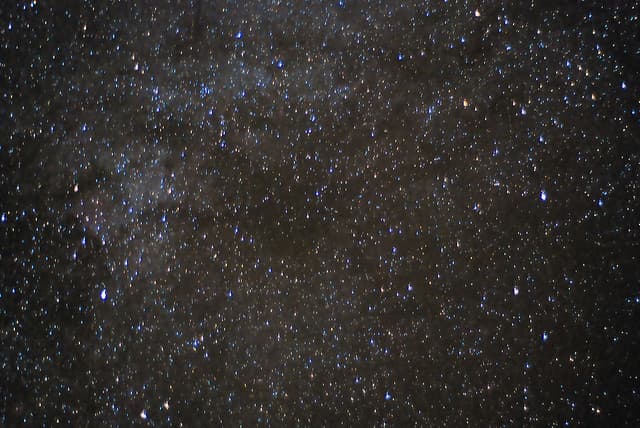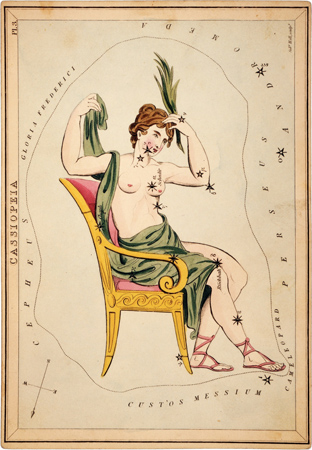Star Gazing: What to Look for October Through December
Agnieszka Spieszny 09.30.11

The ancient Greek story of a beautiful but doomed daughter saved by a man with shoes that allowed him to fly is immortalized in the night sky above you. There’s also the story of a friend who resolved to spend his entire life as a swan and die as a swan in return for saving his friend’s corpse. There’s a hunter, a flying horse, a dragon, twins, bears… The sky is a great tome of stories going back to an ancient time of heroes and adventures. Here’s a guide to intrigue you and help you recognize the constellations the next time you are out in the wilderness far from the pollution of city lights.
Not only is it interesting to gaze at the night sky when venturing far into the wild, but it will help you find your way back to civilization when you’ve ventured too far. This guide in particular applies to star gazers and navigators in the Northern Hemisphere.

Use the above sky chart between midnight and 1 AM in October (Daylight Saving Time), between 9 PM and 10 PM in November and between 7 PM and 8 PM in December.
Notable observations in the October sky are:
Ursa Minor [Little Dipper] – Also known as Little Bear, this constellation is the starting point in any observation. The North Star (Polaris) is always hinged stationary in the sky while its “attached” constellation appears to spin about it and the rest of the night sky follows suit. This constellation is one of few that is visible all year round.
Look for 7 stars that appear in the shape of a small cooking pot. The “ladle” or “handle” of the pot is long and curved; at its very tip you find the North Star. Start heading in the direction of this star as if you’re following it, and you are walking north.
Ursa Major [Big Dipper] – The big brother constellation to Ursa Minor is Ursa Major or the Great Bear. It appears northeast of the little dipper. It is just above the northern horizon between midnight and 1 AM and looks similar to Ursa Minor but with a larger “container” and a longer, straighter handle.
Each constellation is associated with several legends. One legend says the Greek god Zeus seduced one of virgin huntress Artemis’ followers, Callisto. Callisto birthed him a child, Arcas. Zeus’ wife Hera became jealous and transformed Callisto into a bear. When her son Arcas came upon bear Callisto he prepared to shoot her down. Zeus intervened and turned Arcas into a bear as well and threw them both in the sky by their tails before either was harmed but doomed never to rest as their constellations are visible year-round, never falling beneath the horizon.
Draco – Draco means “dragon” in Latin. Look for a long string of stars forming a half-circle around the northern part of the Little Dipper and curving into a backward “S” shape back west to form the head of the dragon with four stars in an oblong trapezoid.
Legends of this dragon abound as the various dragons slayed throughout mythology to reclaim control of a place or as a task to prove oneself. Hercules killed the dragon Ladon as one of his 12 labors, Cadmus killed the dragon when founding Thebes, Greece, Jason killed the dragon to attain the golden fleece, even Adam and Eve originally met the dragon before it become known as a serpent.
Cygnus – Look for a cross in the sky. If the sky is clear enough to see the Milky Way, the cross lies directly in the path of the visible, milky trail. Cygnus is actually made up of the five stars forming a cross and a few more that extend the shorter bar of the cross to make the wings of a swan.
Cygnus is represented as a swan in mythology as the various incarnations or eternal pictures of legendary swans such as in Ovid’s Metamorphoses, but wide-known to be Cygnus from a Greek myth who voluntarily gave up his man’s life for the life of a swan to save his friend’s body from a river.
Cassiopeia – Look for an elongated, slanted “W” formed by five stars. In terlaced myths abound about this constellation and nearby constellations that make up Cassiopeia’s husband, daughter and her daughter’s saviors – explained below.
terlaced myths abound about this constellation and nearby constellations that make up Cassiopeia’s husband, daughter and her daughter’s saviors – explained below.
Cepheus – Cassiopeia’s husband and king of Ethiopia. His constellation is formed by a triangle and rectangle side-by-side. The shortest leg of the triangle makes up one side of the imperfect rectangle.
Andromeda – Cassiopeia’s daughter who was sentenced to death but saved by Perseus. Look for her constellation beginning from the star of the Great Square of Pegasus closest to Cassiopeia. Andromeda’s constellation extends its limbs from there toward Cassiopeia and Perseus.
Perseus – Andromeda’s savior and future husband. It can be made up of almost 20 stars forming the shape of a man with a triangular hat who appears to be made out of children’s old wooden blocks. Look for a triangle connecting Cassiopeia, Andromeda and Perseus.
The legend of these constellations stems from the vanity of Cassiopeia, who bragged about her beauty and that of her daughter’s, angering Poseidon, the powerful god of the sea. He threatened to destroy Cassiopeia and Cepheus’ kingdom but Cepheus made a deal with him to sacrifice his daughter Andromeda if Poseidon would spare his kingdom. Andromeda was chained to a cliff awaiting death when Perseus fell in love with her when traveling by the coast and saved her from the monster that was to kill her.
Pegasus – Pegasus was the flying horse of Perseus, not Hercules as shown in the Disney film. Look for a square called the “Great Square of Pegasus” near the mix of all the above constellations woven together in one legend. Out of two stars that make up near perfect right angles are two limbs that constitute the horses head and front legs. Technically there are three stars with limbs, but one belongs to the constellation Andromeda.
Orion – Also known as the Hunter, Orion is one of the most easily visible constellations in the sky. He appears on the eastern horizon between midnight and 1 AM in October. Look for three bright stars in a row on a slant that make up his belt. The more bright stars above the belt (depending on your point of view) make up this body with broad shoulders.
Legend says he’s had his hand in a number of projects that shaped the appearance of the world like the Sicilian Straits, but he was also a figure in Homer’s Odyssey as a hunter in the underworld. One legend states that he was the son of sea god Poseidon, and another that he hunted with the huntress goddess Artemis.
By definition, a constellation is not merely a picture made up in the sky by connecting the dots on the stars. It is an entire slice of sky pieced by rectangles which contain the star formations mentioned above. Located within some of the constellations are other stellar phenomena. For example, below the three stars that make up Orion’s belt there seem to dangle three more stars as either a loose belt loop or sword that’s facing the ground. One of the stars is actually not a star, but the Orion nebula, a massive star formation or cloud of star dust. I highly recommend that you bring a telescope along to really blow your mind.

